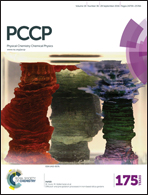Distinction of electron pathways at titanium oxide/liquid interfaces in photocatalytic processes and co-catalyst effects†
Abstract
Photocatalytic reactions include several different steps and routes for photoexcited carriers, and each dynamic is closely related to the reaction efficiency. Although commonly used time-resolved techniques can reveal the kinetics of photoexcited carriers, the reaction pathways are difficult to distinguish due to decay kinetics extending over many temporal orders and various contributions from the carriers and species involved. Herein, we report the distinction of the electron dynamics in the photocatalytic processes of titanium oxide through the combination of the transient grating method and maximum entropy analysis for the estimation of time constants. We were able to confirm three different carrier responses corresponding to an intrinsic recombination, an interfacial transfer or the decay of surface-trapped electrons, and the decay of polarons. Based on the responses, it appears that both gold and platinum work as good electron acceptors, but that only platinum shortened the lifetime of the polaron state due to the acceleration in the adsorption/desorption exchange of ions, which explains the shorter cycles of the photocatalytic reactions for platinum.



 Please wait while we load your content...
Please wait while we load your content...